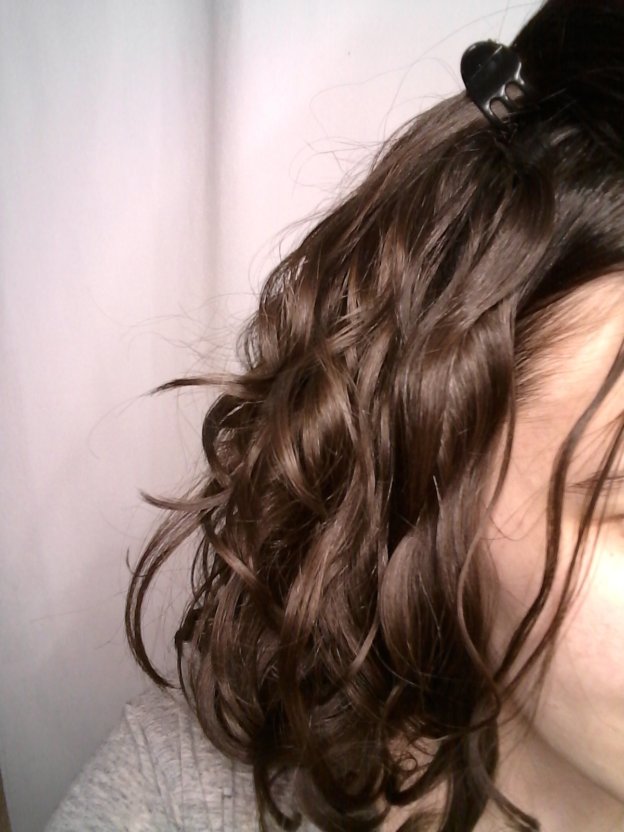In my last post I talked about what causes frizzy wavy hair. There are lots of potential causes and understanding them can be really helpful so I recommend reading that. Thankfully, there are lots of potential fixes, too! If you can pin down what is causing your frizz, that is likely to help you choose the right way of getting rid of frizzy hair.
I always use my own personal photos in all of my blog posts, so I’m going to do that in this blog post as well. I feel like I should post a bit of a disclaimer in this particular post. Fighting frizz is not one of my highest priorities when making my hair routine. I am okay with some frizz. I find that I have to accept a little more frizz to get the volume that I want.
Some of these techniques I do follow, but others I don’t, because they contradict other methods I could use to get more volume. Anyway, so my disclaimer is that I don’t follow all of these all of the time, personally.
Still, I have seen a dramatic improvement in the amount of frizz that I have over time, thanks to the method that I do implement. So, you don’t necessarily have to do all of these to see improvement over time.
I plan to do some routine blog posts eventually and in those you’ll be able to see what techniques I do and don’t utilize if my personal hair care methods are of interest to you.

How To Reduce Frizz In Wavy Hair
Don’t brush your hair except while in the shower with conditioner in your hair. If you brush your hair after showering or while your hair is dry, this will separate your curl clumps and is likely to introduce some frizz.
Dry brushing, especially if you don’t do so very gently, can cause damage by breaking your hair. I had really tangly hair before I started the curly girl method and I thought I had to brush through my knots. I didn’t realize that I was making my hair even more damaged and tangle-prone by using a brush to break up the knots.
Also if you brush harshly and it breaks hair off, this can cause “fly-aways” if the broken pieces of hair are just a couple inches long or shorter, they won’t align well with the rest of your hair.
Use styling products with strong hold. Day to day, this is by far the best thing for reducing the appearance of frizz. It feels like an adjustment to use a product like gel or mousse if you’re not used to leaving products in your hair. I really was resistant to using gel at first, too.
Once I saw how much it helped with my frizz and my wave definition, I quickly changed my feelings on gel! Check out my post What Is A Gel Cast & How To Create One if you’re new to the idea of gel.
Be mindful of humidity when hair is drying. The moisture level in our hair tries to balance out with the air. If unbalanced with the air, our hair will try to pull water from the air into our hair, or the air will steal water out of our hair.
When this transfer of water happens, it can cause our hair to frizz. Try to avoid letting your hair dry while in a humid climate. For example, if your bathroom gets really steamy from your shower, it’s probably best to diffuse in another room instead of diffusing while staying in the humid bathroom.
Be mindful of humidity, dew point and humectants. While our hair interacts with the air naturally, humectants can heighten this effect because they try to help moisturize your hair by ‘borrowing’ water from the air. This is great of the weather is in certain conditions, but if the air is really dry, humectants can do more harm than good.
Humectants work best when the weather is within a certain dew point range. I still have a lot to learn in this regard, myself! Glycerine is perhaps the most common humectant and a lot of people recommend avoiding glycerine in dry weather, which in many areas would be during the winter.
Air dry instead of diffuse. In my blog post about diffusing vs air drying I share how diffusing is helpful for me. I diffuse every single wash day, air drying isn’t very practical for me. However, diffusing definitely can introduce frizz.
If you do want to diffuse for volume purposes, or just because your hair takes too long to air dry, you can still minimize how much friz it causes. Moving the diffuser around less, and making gentle movements when using it can help. You could also hover diffuse so that the diffuser doesn’t touch your hair. Using lower speed or heat may reduce how much frizz is created as well.
Don’t touch your hair. Touching your hair can introduce frizz, especially if you touch your hair before it has dried. I have a habit of twisting the section of hair near my face and flipping it between two of my fingers.
It’s something I think I’ve always done, and it’s something I do unconsciously so it’s been a tough habit to break. Often by day 2 or day 3, that section that I play with is dry, fluffy and frizzy.
Don’t use a towel on your hair. Traditional bath towels have a lot of texture to them compared to other fabrics. All that texture can create more friction which can cause hairs to break loose from their curl clumps and become frizz.
Using a low-texture and low-friction material such as a cotton t-shirt or microfiber towel are a better option that will cause less frizz. Or just skipping over touching your hair with a fabric at all.
Clarify often enough to reduce build up. I haven’t found anywhere that explains why, but lots of sources online say that if you have product build-up on your hair, that can cause frizz. I have noticed this in my own hair as well, I just don’t understand why build-up contributes to frizz.
Anyway, if you haven’t used a clarifying shampoo in a while and have a lot of frizz, give it a try! Most people in the wavy/curly communities I’m in seem to clarify at least once a month. Need a clarifying wash day routine? Click that link to go to a blog post sharing one.
Wet style instead of damp styling. In my blog post about wet styling vs damp styling, I explain why I damp style. It has its benefits, but wet styling is a better option if you’re wanting to prioritize having minimal frizz.
Sleep on silk or satin. Sleeping on your pillowcase can be fairly similar to rubbing fabric against your head. If the fabric has any texture to it at all, it can introduce frizz. Sleeping on a silk or satin pillowcase, or wearing a silk or satin bonnet or buff can result in less friction than sleeping on a cotton pillowcase.
Putting hair up while sleeping. Keeping your hair up while sleeping can keep it from rubbing against your bedding as much. Check out my post how to sleep on wavy hair to learn how to put your hair u in a “pineapple” to protect it without crushing your waves.
Upright styling. I like to style upside down, and you can read about why in my post upright vs upside down wavy hair styling. However, if your top priority is to minimize frizz, rightside up styling (and washing) may be best. Moving your hair around can introduce frizz, and if youwash or style upside down, that means you have to flip your hair at least once.
Make sure hair is 100% dry before breaking the cast. If you get a gel cast (or a cast from your mousse or other styling products) and you try to scruch out the crunch before your hair is totally dry, this can introduce frizz. I don’t know why this is, but I’ve experienced it a lot myself. I always wait a while after I think my hair is totally dry before breaking the cast.
Try to cut out coconut and/or aloe. I haven’t experienced this myself, but I have seen many people say that their hair is sensitive to coconut, or sensitive to aloe. Some find that these ingredients cause their hair to react poorly and frizz up.
Refresh with moisture. If you find that your frizz is primarily showing up on day 2 or later, refreshing your hair by adding in a little more leave-in conditioner may help keep your hair moisturized better between washes.
Protect your hair from friction. Everything from the back of chairs, to the headrest in your vehicle, to the collar on your shirt can create friction on your hair and result in frizz. If these seem to be major causes of frizz for you, it may make sense to make adjustments to avoid or reduce them.
For example, people in wheelchairs with headrests may find that they get a lot of frizz in the back of their head due to their headrest. Getting a satin or silk cover for the headrest may help.
The Curly Girl Method Helped My Frizz

This picture above is on a day right around the time I started the curly girl method, but when I hadn’t used any products. My hair was really frizzy when I didn’t use gel! I almost never wore my hair down before I started the curly girl method because my frizz was so severe, I found it embarrassing.
The photo below is after a couple of months of the curly girl method on a day when I had used gel though I suspect, not quite enough. While still frizzy, I had an immediate improvement in my frizz when using the curly girl method.
I believe the biggest helps were using gel, not brushing my hair, and sleeping on satin. I was really excited to see this overnight improvement in my frizz level just by incorporating these tricks. I started to feel like I could wear my hair down which was a real victory for me at the time.

While not a true cure, these day to day little technique tips (using stylers, not brushing, sleeping on satin, etc) helped a lot. The main reason they weren’t a true cure was because I had broken hairs near the top of my head that stuck out because of how short they were (an inch or so).
I slowly got less and less frizz over time as my hair grew out and as I continued to treat it gently by using gentler products, not brushing and causing more breakage and so on. My hair slowly started to feel less rough, it was softer and just felt healthier.
My hair has gotten significantly less frizzy over the last couple of years thanks to being more moisturized and cared for better, resulting in it being less damaged. Even when I don’t use any products with hold now, I have a lot less frizz than I used to.
My hair was not chemically damaged or heat damaged even before I starte the curly girl method. If your hair is chemically damaged or heat damaged, you may see even more dramatic improvement than I did. However, damaged hair can take a long time to repair so it can require a lot of patience.
I am glad that I stuck with it because my hair is a lot less frizzy now, even when I use no products like in the picture below.

My hair without any products with hold after 2+ years of curly girl method.
How To Tame Frizzy Hair Longterm
If you really struggle with frizz, the solution will require long-term care. The solutions above are great for reducing frizz day to day. However, frizz is often the result of damaged hair. If your frizz is caused by damage, it will require that your hair gets healthier before you see a dramatic improvement in your frizz. Some ways to work on long-term frizz solutions…
Get hair better moisturized.
Really frizzy hair is often really lacking moisture. Some ways to get your hair more moisturized over time include:
- Using a good conditioner
- Using a lot of conditioner so your hair is well-saturated.
- Leaving the conditioner in your hair for a few minutes before rinsing it out.
- Doing deep conditioner treatments (once a week or so)
- Using leave-in conditioners or creams.
- Washing Hair Less Often. If you’re in the habit of washing frequently, this can leave your hair more dry. Washing less frequently will give your scalp oils more time to travel down your hair and moisturize your strands.
- Using gentler ingredients (gentler cleansers, avoiding drying alcohols, etc)
- Squish To Condish. This technique can help your conditioner work better in your hair. You can read about How squish to condish helps moisturize hair by clicking that link. It’s an article from Scienc-y Hair Blog.
Cut off damaged ends.
This is one of the best things I did for my hair a few years back. It was constantly tangled due to the damaged ends and the tangles were really tough to work out, so I’d end up using a brush on them, which caused even more damage. Cutting the ends off made my tangles less, which made me brush less, which resulted in damaging the rest of my hair less.
Avoid dyeing or heat.
Heat and chemical treatments like dying or perming are some of the most damaging things we do to our hair. If you’ve done these in the past and are willing to stop them, your new growth will come in much healthier and less frizzy.
Products that help with frizz
People commonly want to be able to buy a product to get rid of their frizz. Before I realized my hair was wavy, I bought all sorts of anti-frizz serums and creams. Most of them would appear to work when first applied, but my frizz would re-appear after less than an hour. Same thing with various oils that I bought because I heard they helped with frizz.
I tried argan oil and coconut oil, and others. With the oils and frizz-serums and anti-frizz creams, they basically were just slicking the frizz down while damp, and then once the hair dried again it would frizz back up. They may have been helpful if I wanted to tamp my frizz down before photos were taken or something like that. They weren’t good all-day solutions though.
If there are frizz-specific products that can be applied to reduce frizz that really work well, I haven’t seen anyone talk about them in wavy or curly hair communities.
Using a product with hold like gel or mousse does far more to keep frizz at bay than any of the specific anti-frizz products I tried.
The other thing that I have heard works is using a dryer sheet on your hair if the frizz is from static. Dryer sheets help neutralize static, so if your hair is staticy, they can help!

This is my day 3 hair. Yep, I have frizz. I would (and do!) wear my hair this way when going into public.
Frizz Is Natural In Wavy Hair
When talking about frizz and how to tame frizzy wavy hair, I think it’s really important to keep in mind that frizz is a natural part of having wavy hair.
I think sometimes those of us with textured hair have expectations for our hair that are based on straight hair properties. Expecting really smooth, sleek hair is one of those traits that I think is only really seen in straight hair. It’s not very fair to our natural hair texture to expect it to be have like straight hair when it is not straight.
Sometimes I see people post pictures asking for help managing their frizz and I honestly have no idea what they’re talking about because I see no frizz or so little frizz that I never would have noticed it at all. We see things when staring at ourselves that most other people would never notice. Low-level frizz is definitely one of those things.
One of the benefits of having textured hair is that it’s not smooth and sleek, so what frizz we do have can be somewhat hidden in the curves of our waves.
Some other blog posts of mine that may interest you:
How to get wavy hair to last longer
How the real curly girl method is different from how the curly girl method is talked about online
One thing that made a noticeable difference in my getting poofy-frizz vs wave-clumps was getting a water filtering shower-head. Hard water is bad news for wavy hair. Any hair, really, but especially if you already have problems with dryness or old damage.